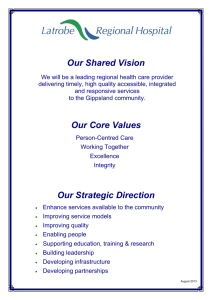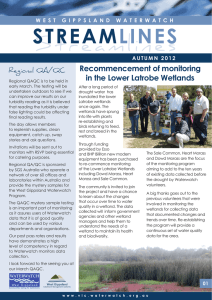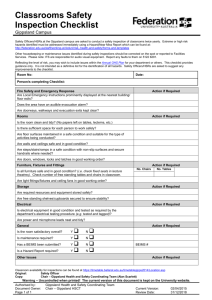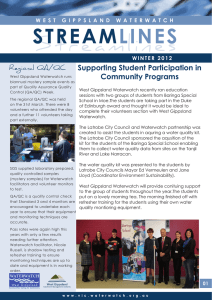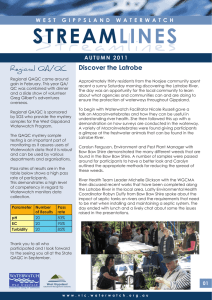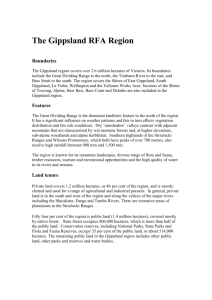Gippsland STREAMLINES Inside This Issue: Waterwatch Monitors the
advertisement
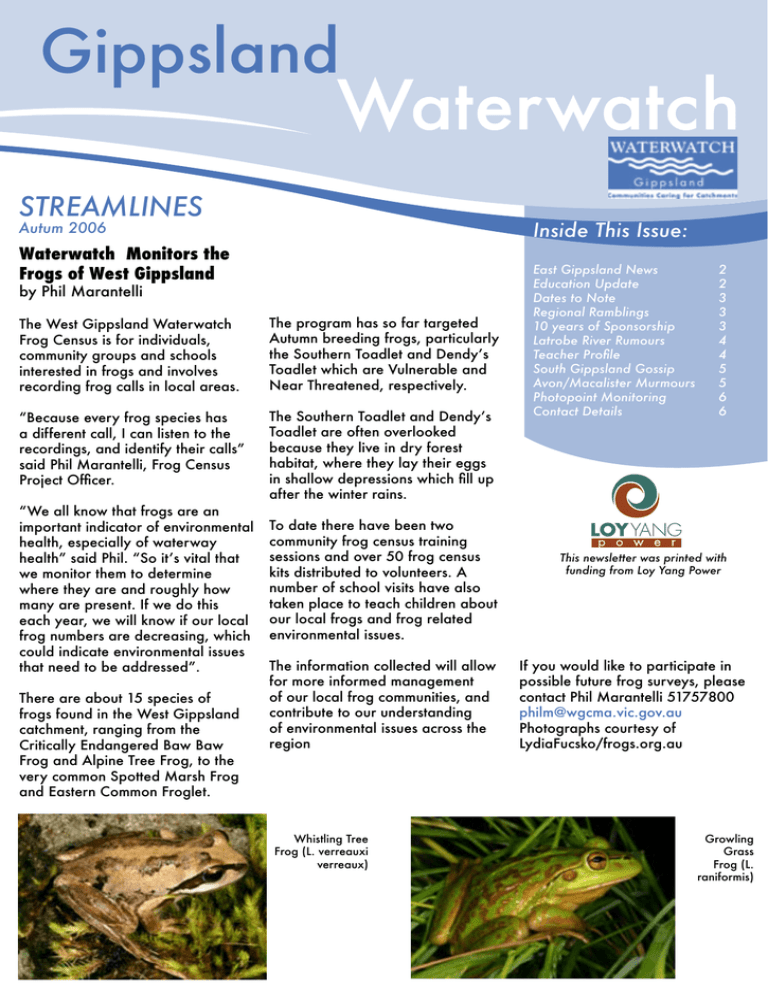
Gippsland STREAMLINES Autum 2006 Waterwatch Monitors the Frogs of West Gippsland Waterwatch Monitors the Frogs of West Gippsland The West Gippsland Waterwatch Frog Census is for individuals, community groups and schools interested in frogs and involves recording frog calls in local areas. The program has so far targeted Autumn breeding frogs, particularly the Southern Toadlet and Dendyʼs Toadlet which are Vulnerable and Near Threatened, respectively. “Because every frog species has a different call, I can listen to the recordings, and identify their calls” said Phil Marantelli, Frog Census Project Officer. The Southern Toadlet and Dendyʼs Toadlet are often overlooked because they live in dry forest habitat, where they lay their eggs in shallow depressions which fill up after the winter rains. by Phil Marantelli “We all know that frogs are an important indicator of environmental health, especially of waterway health” said Phil. “So itʼs vital that we monitor them to determine where they are and roughly how many are present. If we do this each year, we will know if our local frog numbers are decreasing, which could indicate environmental issues that need to be addressed”. There are about 15 species of frogs found in the West Gippsland catchment, ranging from the Critically Endangered Baw Baw Frog and Alpine Tree Frog, to the very common Spotted Marsh Frog and Eastern Common Froglet. by Phil Marantelli To date there have been two community frog census training sessions and over 50 frog census kits distributed to volunteers. A number of school visits have also taken place to teach children about our local frogs and frog related environmental issues. The information collected will allow for more informed management of our local frog communities, and contribute to our understanding of environmental issues across the region Whistling Tree Frog (L. verreauxi verreaux) Inside This Issue: Waterwatch Monitors the East Gippsland Frogs of WestNews Gippsland 2 Education Update byDates Phil to Marantelli Note Regional Ramblings 10 years of Sponsorship Latrobe River Rumours Teacher Profile South Gippsland Gossip Avon/Macalister Murmours Photopoint Monitoring Contact Details 2 3 3 3 4 4 5 5 6 6 This newsletter was printed with funding from Loy Yang Power If you would like to participate in possible future frog surveys, please contact Phil Marantelli 51757800 philm@wgcma.vic.gov.au Photographs courtesy of LydiaFucsko/frogs.org.au Growling Grass Frog (L. raniformis) East Gippsland News by Becky Van Der Heyden The Snowy River Canoe Tour was held on Saturday May 6th. The sun was shining and the river was still. We stopped in at Lochend Boat ramp for a great big yummy lunch and a stroll through the Lochend Jungle with Bill Peel from the EGCMA. The day was fantastic and enjoyed by all with lots of great questions and suggestions throughout the day. After learning how to stay dry and not fall out of the canoes (thanks to the guys from GOTYA) we were set to make our journey. Participants learnt about the riparian rainforest, negative effects of willows, the history of the river, large woody debris, restocking of native fish and the Snowy River Schools Project. Thank you to everyone who attended: the guys from GOTYA, guest speakers, caterers and the weather! Rafting up along the bank to listen to a guest speaker along the way Education Update Grabbing a bite to eat before a wander through the Lochend Jungle by Marni Speed Action in Our Catchment! the fuel reduction burns in the area helped to control the fire. Bringing together current and future natural resource managers in the region, and enabling students to contribute to a sustainable future. Peter West led the tour, “Itʼs a fun and interesting way for them to learn and a great opportunity for DSE and our partner agencies to work with future natural resource managers and increase awareness of environmental issues,” he said. Gippsland schools have been busily preparing presentations for the “Action in Our Catchment” conference, to be held on World Environment Day, June 5 2006. The conference provides students with an opportunity to present an overview of an environmental project that they have been working on in partnership with other organisations such as DSE, water authorities, community groups and Waterwatch. The conference also gives students the ability to voice their hopes for the future state of the environment. The conference is being coordinated by West Gippsland Waterwatch and the Gippsland Integrated Natural Resources Forum (GINRF) in partnership with a number of other agencies involved in catchment management in the region. Grade 5 and 6 students from Flinders Christian Community College in Traralgon will be giving a presentation on their project, entitled “Cry Me a River”. The project aims to monitor the impacts of the Moondarra fire on water quality and wildlife and has been assisted by Waterwatch and the Department of Sustainability and Environment (DSE). The project has involved a presentation from Colleen Wood from Southern Ash Wildlife Shelter talking about rescuing wildlife after the fire; an orienteering and an animal identification activity presented by DSE Forest Manager, Peter West, and monitoring the water quality of the Tyers River with Marni Speed from Waterwatch. Top and bottom: Grade 5 and 6 students from Flinders Christian Community College sample water from the Tyers River with Marni Speed. “The project has aligned well with the school curriculum and came at the right time for the students” said teacher Angela Daniels. “Weʼre doing “Planet Earth” and the water cycle and catchment story, so this all links in very well” she said. The students also embarked on a bus tour to examine some of the effects of the Moondarra fire on local forest areas and how 2 Dates to Note Our Estuary – Get to know it! Quality Assurance/ Quality Control Week Action in Our Catchment Conference Down to Earth Wetlands Night Estuarine Explorers Expo National Water Week Lake Narracan Catch A Carp Day Regional Ramblings 2nd June 2006 4th -10th June 2006 4th June 7th June 2006 13th June 15th – 21st October 26th November by Becky Van Der Heyden and Tammy Dawson In the East... In the West... We have been flat out in East Gippy. Weʼve had Clean up Days, Saltwatch Week; Catch a Carp Day, East Gippsland Field Days, and Canoe Tour, Mitchell River Walk and Talk, and heaps of school visits! All of these events had great weather every day! I would like to give a big warm welcome to Bruthen Landcare Group and Orbost Angling Club. Thank you to Shopping Trolleys pulled everyone who contributed to and out of the Mitchell River at attended these events. the Port of Bairnsdale on Hi Waterwatchers, I would like to introduce myself as the new Regional Coordinator for West Gippsland. Most of you would already know me from my previous role as the Latrobe Facilitator, so I would just like to say that I am extremely excited to be in this new position and I look forward to the continued growth and maturation of the Waterwatch program. Marni Speed has also changed hats from Education and Professional Development Officer to the Latrobe Facilitator. Marniʼs previous work in the education sector and with volunteers from other organisations means that she is well equipped for the role. Clean up Australia Day Recognising 10years of Sponsorship Earlier this quarter West Gippsland Waterwatch recognised 10 years and 5 years of Sponsorship to the program. Sponsors were invited to enjoy lunch with the Waterwatch team and were presented with certificates signed by the Minister for Water, John Thwaites. by Tammy Dawson “Waterwatch is truly a partnership program, drawing expertise from many stakeholders involved in catchment management” said Tammy Dawson, Regional Waterwatch Coordinator “It is the reason we continue to deliver successful education resources and activities into schools and the community”. “We are delighted to be able to assist Waterwatch to continue its excellent work in raising awareness for the need to protect our waterways and catchments. The work they do with the community and schools to encourage everyone to consider the impacts of their actions on local creeks and rivers is resulting in improved waterway health. Loy Yang Power look forward to continuing and growing their relationship with Waterwatch in the future” said Russell Center, Senior Manager, Sustainability, for Loy Yang Power. Below: (Left to right) Richard Appleton, Grandridge Plantations; Rob Stallard, ESSO Australia; Martin Fuller, West Gippsland Catchment Management Authority; Christina Colantuono, Gippsland Water; Sheldon Harvey, SGS Environmental Services; Neil Bennie ESSO Australia; Hanna Wardell, Deputy Chair WGCMA. Gippsland Water and ESSO Australia received certificates for 10 years of contributions, while the West Gippsland Catchment Management Authority, Grandridge Plantations, Loy Yang Power, SGS Environmental Services, Southern Rural Water, and South Gippsland Water received certificates for 5 years of ongoing support. Other sponsors such as TRU Energy and the Gippsland Lakes Future Directions and Action Plan were also thanked for their sponsorship in recent years. 3 Latrobe River Rumours by Marni Speed School Grants Program Neerim Secondary College, Cloverlea Primary School and St Paulʼs Anglican Grammar Traralgon. Funding from the Gippsland Lakes Future Directions and Action Plan has enabled schools in the Gippsland Lakes catchment area to apply for a grant to receive either a Water Quality Monitoring Kit or a Macroinvertebrate Monitoring Kit. I will be working with these schools to put their monitoring plans Above: Water quality monitoring kit into action and am looking forward to seeing the data they collect in the months to come. Well done to these schools and the other schools in the Latrobe region who are also engaged in Waterwatch activities. To receive a grant, schools had to provide a water quality monitoring plan to demonstrate that the kit would be used in an ongoing capacity to expand their units of work. Schools in the Latrobe region jumped at this opportunity and I am pleased to announce the successful applicants in the Latrobe region are: Newborough Primary School, Warragul Regional College, Flinders Christian Community College, Commercial Road Primary School, Narracan Primary School, Neerim & District Rural Primary School, Teacher Profile by Fiona Stevens Name: Greg McNamara awarded an ASISTM grant of $78,000 called Totally Spatial! Seamless Information & Communication Technology (ICT) in Teaching Science. It is to train teachers in the use of GPS and GIS so that they can write ICT rich science units and teach kids seamlessly about GPS and GIS while teaching science. School: Snowy River Cluster Involved with Waterwatch since: In this capacity since 2004 Parameters monitored: pH, Temp (air/water), P, Turbidity, EC, Dissolved O2 as well as water bugs Started monitoring: 2004 What do you enjoy most about Waterwatch: The way it gets the kids really excited about their local environment What Projects are you involved with: My cluster project is called Snowy River Thinking, mainly because Lower Snowy River Rehabilitation Trial Schoolʼs Program is too much of a mouthful! This project is aimed at establishing a rapport between cluster students and their local river, the Snowy, while monitoring changes in the river brought about by local rehabilitation and upstream alterations such as changes to the Jindabyne Dam, removal of Willows and natural events such as storms. Greg McNamara For more information Greg can be contacted on: Greg McNamara, Snowy River Thinking & ASISTM Totally Spatial! Teacher Coordinator P 03 5154 8236 F 03 5154 8200 M 0412 211 797 E gregmc@mc2.vicnet.net.au In addition to the SRT programs we have run an additional program called Snowy Growy [called SCIps funded by DEST through ASTA) where students in Yrs 5-6 grew local plants used in revegetation sites from seed and experimented with germination variables to see if they could establish better rates of germination for some of the species. Also, we have recently been 4 South Gippsland Gossip by Tanya Cowell The Leongatha Green Corps group has started up with 10 team members, I will be working with the group on a monthly basis logging data on macroinvertibrate and phys/chem. parameters of several waterbodies in the Koonwarra/ Leongatha. The group will be working on weed removal, revegetation and other environmental projects in the area over the next 6 months. I am looking forward to working with this enthusiastic team led by Tony Gardner. Waterwatch Facilitator know, we will keep you in mind for up coming training. Mary MacKillop CRC South Gippsland has received aWaterwatch macroinvertebrate kit through our school grants program.. Paul Stampton, Mary MacKillop CRC Science Coordinator noted that, “The College has just begun a programme in VCE Environmental Studies. Unit 2 is centered around ʻMonitoring the Environmentʼ the Waterwatch programme seemed ideally suited to the curriculum”. The class will be monitoring on a fortnightly basis at several sites along Coalition Creek, tracking changes downstream using several parameters including macroinvertebrates. This data will be an asset to the South Gippsland Waterwatch database and provide an excellent data set for the students to report on. Welcome to new volunteers Ian Atkin (Ayr and Wreck Creeks, Inverloch (4 sites)) and John Honeybone (Screw Creek and Little Screw Creek, Inverloch (4 Sites)). In April Waterwatch Victoria ran a three day macoinvertebrate workshop. Experts in their field Edward Tsyrln and John Gooderham presented at the workshop held at Monash Unversity, Melbourne. A very interested South Gippsland volunteer, John OʼGrady from Allambee was sponsored by South Gippsland Waterwatch to attend this training. John reported that “the course was excellent”, he “thoroughly enjoyed the whole thing.” John thought the “presenters were excellent, very knowledgeable, and presented well.” “The practicals were similarly very good, and we went through all the Orders in the macroinvertebrates, with lots of microscope exercises in identifying further to Family level.” It is fantastic to see that John who is a histopathologist, has enjoyed gaining identification skills in a microscopy field. If you have particular areas of interest please let your local Avon/Macalister Murmurs Preparations continue for the Estuarine Explorers Expo (13th June) with 7 schools with approximately 200 grade 5/6 students to attend, more in the next newsletter about this event. Top Left: Green Corps team members identifying macros from a wetland on the Koonwarra rail trail. Left: Year 11 students from CRC South Gippsland with their new macro kit. by Greg Gilbert In mid May, 20 State Waterwatch coordinators and facilitators converged on Sale and its wetland environment for important water bug training. microscopes, while utilising a room at ACES, Sale. The training also provided the opportunity to trial a web-based macroinvertebrate identification tool. Each year the State Waterwatch Science Coordinator holds a training session for the Waterwatch team on macro invertebrate assessment. Murray Darling Basin Commission Unit of Freshwater Ecology (MDBCFE) scientist and author John Hawking and his two assistant scientists Lyn Smith and Kathie Le Busque have mostly been the means to this training in past years. Down To Earth Wetlands Sale Waterwatch will hold an evening in June to highlight ten years, particularly of monitoring in Dowdʼs Morass. The night will also recogniee longer time volunteers generally and give an opportunity for the local groups to converge for an interesting evening of community presentation. It was of particular pleasure to have John at Sale and to utilize our local environment for this activity, as he is to retire later this month. The training took the group to two sites on the lower Macalister River and two wetland sites alternately with low and high water salinity respectively. Sale College and Gippsland Grammar teachers locally are the first to have shown interest in this new educational game that broadens studentsʼ understanding of the state governmentʼs new Environmental Water Reserve. These teachers will be playing the game with other SOSE teachers and in one case, with their teenage children, to better assess how they will introduce it to their curriculum in the near future. Run of the River Over two and a half days of collections were made and followed up by intricate taxonomic assessments using Waterwatch coordinators enter the waters of Dowdʼs Morass for macro invertebrate training. Richard Marchant, Aquatic Scientist from the Museum of Victoria, Heyfield PS 3-4 pupils and a parent at their ʻBugs on Trailʼ collection activity at the Heyfield Wetlands 5 POSTAGE PAID TRARALGON 3844 STREAMLINES - The Gippsland Waterwatch Newsletter Key Stakeholders and Sponsors Gippsland Waterwatch Contacts: Tammy Dawson Phil Marantelli Marni Speed Becky Van Der Heyden Tanya Cowell Fiona Stevens West Gippsland Regional Coordinator 16 Hotham St, Traralgon 3844 Ph: (03) 5175 7800 Email: tammyd@wgcma.vic.gov.au Latrobe Facilitator 16 Hotham St, Traralgon 3844 Ph: (03) 5175 7800 Email: marnis@wgcma.vic.gov.au South Gippsland Facilitator P.O. Box 99, Leongatha 3953 Ph: (03) 5662 4555 Email: tanyac@wgcma.vic.gov.au Frog Census Project Officer PO Box 1374, Traralgon 3844 Ph: (03) 5175 7800 Email: philm@wgcma.vic.gov.au East Gippsland Regional Coordinator PO Box 1012, Bairnsdale 3875 Ph: (03) 5150 3577 Email: bvanderheyden@egcma.com.au East Gippsland Facilitator PO Box 1012, Bairnsdale 3875 Ph: (03) 5150 3578 Email: fstevens@egcma.com.au Greg Gilbert Sale region Facilitator 906 Dolphin Av, Golden Beach 3851 Ph: (03) 5146 3217 Email: ggil@netspace.net.au DPI/DSE Photopoint Monitoring by Tammy Dawson Waterwatch recently held a Photopoint monitoring workshop in which 30 West and East Gippsland Waterwatch volunteers and CMA staff attended. The workshop was designed to introduce Photopoint monitoring as a way of providing valuable supplementary information to quantitative & qualitative data, and to give a good general overview of a situation, landscape or environment. “The camera is a scientific tool, it is an absolute truth – photographs do not lie” said workshop presenter, Alison Pouliot. Alison spent a significant amount of time explaining to participants how to use their cameras, as this tends to be the most problematic area for people attempting photopoint monitoring. Some time was also spent learning about site selection and photo composition. Participant feedback was positive with much conversation about how the workshop had influenced their thinking about photopoint monitoring and how they would be applying techniques to their particular situation. Right: Waterwatch Volunteer, Michael Thompson practices using his camera to photograph the Morwell River Wetlands. Below: Alison Pouliot speaks to the group about photopoint monitoring at this Tyers River site monitored by Waterwatch Volunteer, Peter Steller.
